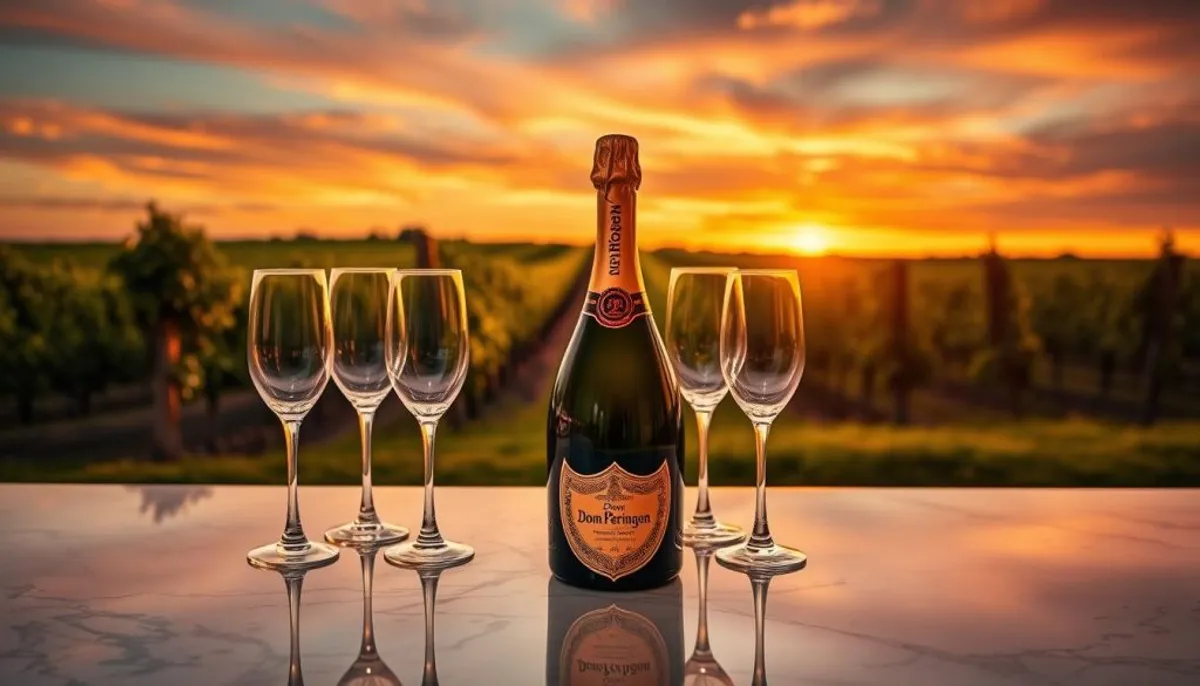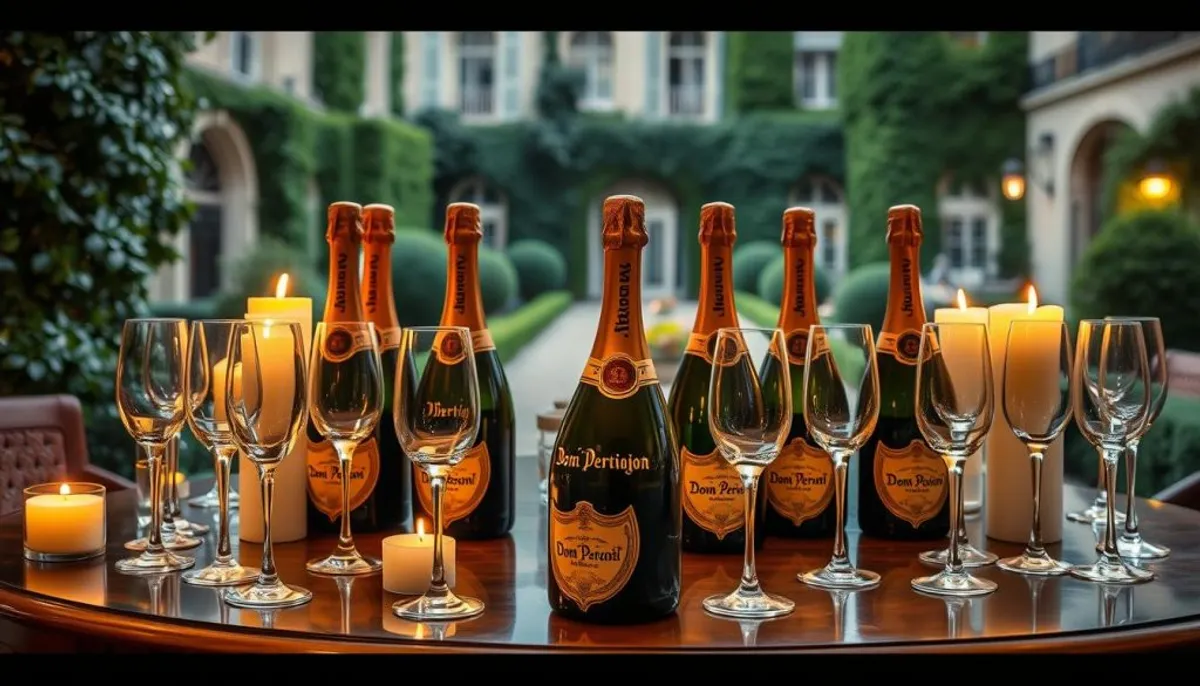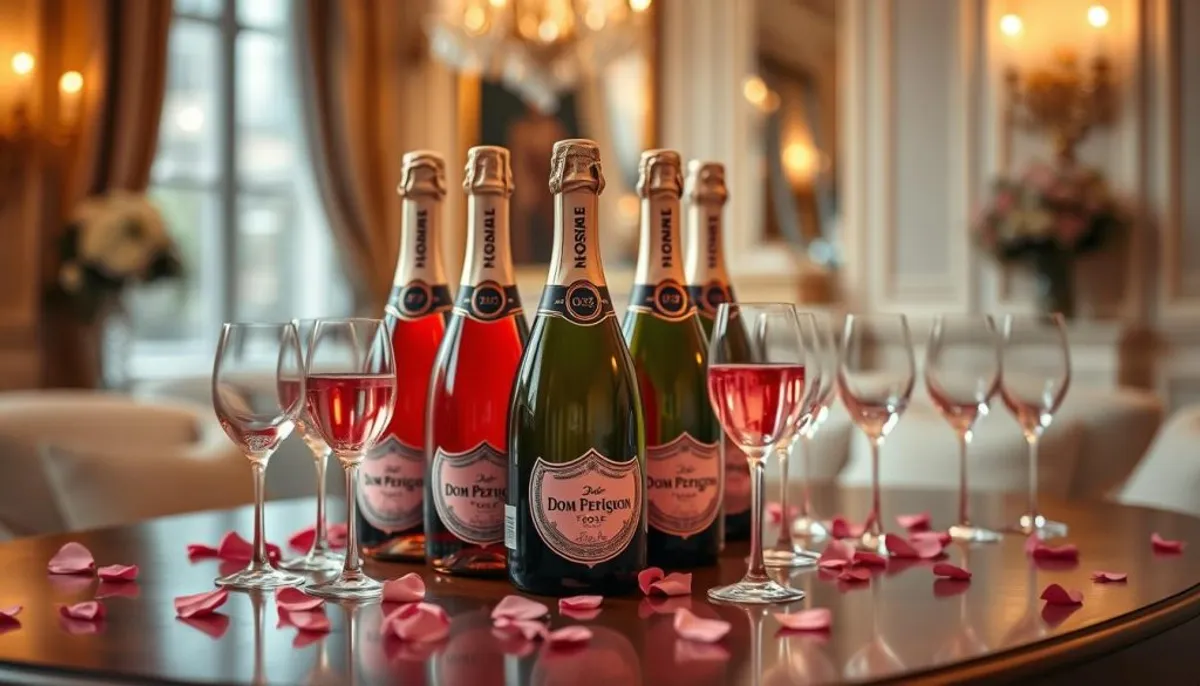Dom Perignon, a name synonymous with luxury wine and prestige cuvée, has long been the gold standard in vintage champagne. This iconic brand, owned by Moët & Chandon, crafts only vintage champagnes. Each bottle is a testament to the art of winemaking.
The story of Dom Perignon begins with its namesake, a Benedictine monk who pioneered several winemaking techniques. Today, the brand continues this legacy of innovation. It produces champagnes aged for at least seven years before release. These exquisite bottles have the potential to age gracefully for over two decades.

Dom Perignon’s commitment to excellence is evident in its selective vintage releases. Since its inaugural 1921 vintage, only 41 vintages have been released. This underscores the brand’s dedication to quality over quantity. This exclusivity has positioned Dom Perignon as a premium product in the champagne market.
The value of Dom Perignon vintages often appreciates over time. For instance, the 2002 vintage, initially priced at around $100 in 2010, now commands about $250. This increase reflects not only the champagne’s quality but also its investment potential.
Key Takeaways
- Dom Perignon produces only vintage champagnes
- Each vintage is aged for at least 7 years before release
- The brand has released 41 vintages since 1921
- Dom Perignon champagnes can age for over 20 years
- Vintage prices often appreciate, showing investment potential
- The brand is known for its selective vintage releases
The Legacy of Dom Perignon Champagne House
The Dom Pérignon legacy is deeply embedded in the annals of Champagne history. This esteemed brand has profoundly influenced the sparkling wine industry for centuries. It has established benchmarks for excellence and luxury, setting a precedent for all to follow.
The Pioneering Spirit of Pierre Pérignon
Pierre Pérignon, a 17th-century monk, was instrumental in transforming Champagne production. His groundbreaking innovations significantly enhanced quality and consistency. These advancements formed the cornerstone of modern sparkling wine production.
Moët & Chandon’s Prestige Cuvée
Today, Dom Pérignon is the epitome of Moët & Chandon’s prestige. This prestige cuvée is crafted exclusively in exceptional vintage years. This dedication to quality underscores the brand’s unwavering commitment to excellence.
The Art of Vintage Selection
The reputation of Dom Pérignon is built on the meticulous selection of grapes. The use of Grand Cru and Premier Cru vineyards ensures unparalleled quality. This rigorous selection process justifies the premium price that Dom Pérignon commands. Additionally, the exquisite gaja barbaresco exemplifies the high standards and craftsmanship that accompany luxury wines.
| Vintage | Robert Parker Score | Notable Characteristics |
|---|---|---|
| 1996 | 98/100 | Intense flavor, vibrancy, crystalline structure |
| 1990 | 98/100 | Generous, warm summer harvest |
| 2008 | 96+/100 | Vibrant freshness, mineral notes, intense |
| 1985 | 96/100 | Classic, refreshing acidity, subtle toasted notes |
Dom Pérignon’s exceptional vintages command impressive prices. Recent releases average €225 per bottle, while rare older vintages can fetch up to €500. The pinnacle of luxury? A Dom Perignon Rosé Vintage Gold in Methuselah format, sold for an astounding €50,000.
Understanding Vintage Champagne Production
Vintage champagne is a pinnacle in the sparkling wine domain. It is produced only in years where grape quality is unparalleled. The meticulous winemaking process for these bottles exemplifies the virtues of patience and precision. One notable example of this excellence is gaja barbaresco, which showcases the artistry involved in crafting high-quality wines.
Dom Perignon, a vanguard in vintage champagne, employs a distinctive blend of Pinot Noir and Chardonnay grapes. The selection of grapes is paramount, with each vintage embodying the essence of its harvest year. Winemakers meticulously select grapes from the most esteemed vineyards across Champagne’s revered regions.
The aging process distinguishes vintage champagne. Unlike regular champagne, which ages for 15 months, vintage varieties like Dom Perignon mature for at least 7 years. This prolonged aging period enables flavors to mature fully, resulting in intricate taste profiles that are highly prized by aficionados.
| Aspect | Regular Champagne | Vintage Champagne |
|---|---|---|
| Production Frequency | Annually | Only in exceptional years |
| Grape Source | Multiple years | Single harvest year |
| Minimum Aging | 15 months | 36 months (often longer) |
| Flavor Profile | Consistent | Unique to each vintage |
The winemaking process for vintage champagne is an art form. It commences with the meticulous selection of grapes and culminates in a product that encapsulates a moment in time. Each bottle narrates the tale of its harvest year, rendering vintage champagne a coveted gem for collectors and connoisseurs.
Best Dom Perignon Vintages Through the Decades
Dom Perignon vintages have consistently stood out as pinnacles of excellence in the world of champagne. Wine collecting enthusiasts eagerly seek out the best years, recognizing their potential for both enjoyment and investment.
The Outstanding 1990s Collection
The 1990s marked a golden era for Dom Perignon. The 1990 vintage, with its almond and toasted brioche notes, remains a collector’s dream. The 1995 and 1996 releases also shine brightly, showcasing the brand’s commitment to quality.
Excellence in the 2000s Era
As we entered the new millennium, Dom Perignon continued to impress. The 2002 and 2004 vintages are standout examples from this period. These releases offer great value and have seen significant price appreciation, making them popular among collectors.

Recent Remarkable Releases
The 2008 vintage has earned high praise, receiving a remarkable 98+ score from Antonio Galloni. It offers floral and stone fruit notes with brilliant acidity. The 2012 release is another recent standout, promising excellent value for collectors and enthusiasts alike.
| Vintage | Notable Characteristics | Price Range |
|---|---|---|
| 1990 | Almond and toasted brioche notes | $553 |
| 2004 | Great value, significant appreciation | $215 |
| 2008 | Floral and stone fruit notes, brilliant acidity | $250-$300 |
With 48 vintages produced since 1921, Dom Perignon continues to captivate wine collectors. The brand’s commitment to excellence across decades makes it a cornerstone of any serious champagne collection.
The Unique Characteristics of Dom Perignon Wine
Dom Perignon distinguishes itself in the champagne realm with its unparalleled wine characteristics and aging prowess. Since its inception in 1921, this label has epitomized luxury and winemaking excellence.
Grape Composition and Blending
The creation of Dom Perignon wines involves a precise blend of Pinot Noir and Chardonnay grapes. The ratio, typically between 50/50 and 60/40, ensures a harmonious and intricate flavor profile. This meticulous blending is key to the wine’s unique taste and its remarkable aging potential.
Aging Process and Development
The aging process is pivotal to Dom Perignon’s superior quality. Each vintage is aged for at least seven years, sometimes extending beyond this period. This prolonged aging allows the wine to fully express its flavors and aromas, enriching its overall character.
Tasting Profile Evolution
The Dom Perignon flavor profile undergoes a remarkable transformation over time. Young vintages present a bouquet of lemon, apple, peach, and pear, accompanied by subtle brioche and mineral undertones. As the wine matures, it deepens, revealing a more complex array of flavors and aromas.
| Characteristic | Description |
|---|---|
| Primary Grapes | Pinot Noir and Chardonnay |
| Minimum Aging | 7 years |
| Young Vintage Notes | Lemon, apple, peach, pear, brioche, mineral |
| Aging Potential | 20+ years |
Investment-Worthy Vintage Selections
Dom Perignon’s rare vintages have emerged as coveted assets in wine investment portfolios. The champagne house’s limited production and stellar reputation have solidified its bottles as highly sought-after by collectors and investors. This demand underscores their value in the market.
Older vintages from the early 20th century command astronomical prices. The 1921 and 1926 releases fetch between £8,000 to £10,000 and £6,000 to £9,000 respectively. These champagnes epitomize luxury and rarity in the wine world.
Recent vintages also demonstrate strong investment potential. The 2008 and 2012 Brut account for over 40% of Dom Perignon sales on LiveTrade, a leading wine trading platform. The 2008 rosé is highly sought after, regarded as one of the most compelling rosé champagnes in recent decades. Additionally, bonang champagne has emerged as a notable contender in the luxury champagne market, attracting attention for its unique flavor and quality.
| Vintage | Investment Potential | Expected Longevity |
|---|---|---|
| P2 2000 | High | Until 2033 |
| P2 2004 | Very High | Until 2038 |
| Oenothèque 1996 | Exceptional | 67% gain in 12 months |
The Plénitudes series, including P2 and P3 releases, presents unique investment opportunities. These late-disgorged vintages, aged for extended periods, reflect Dom Perignon’s dedication to excellence and longevity.
Exploring Dom Perignon Rosé Vintages
Dom Perignon Rosé epitomizes the zenith of pink champagne excellence. It enthralls aficionados with its unmatched quality and scarcity. Among the remarkable selections, gaja barbaresco stands out, and we will explore the distinctive Dom Perignon Rosé vintages, highlighting their unique traits and investment allure.
Notable Rosé Years
Dom Perignon Rosé boasts several standout vintages. The 1995 and 1996 releases are renowned for their perfect harmony and intricate complexity. These vintages underscore the brand’s dedication to crafting superior pink champagnes.

Distinctive Characteristics
Dom Perignon Rosé is distinguished by its distinctive flavor profile. It presents a blend of dried fruit flavors, delicate minerality, and subtle vanilla-spicy nuances. The 2006 and 2008 vintages are celebrated for their robust red berry aromas, floral nuances, and spicy undertones, showcasing the luxury rosé’s profound depth.
Collecting and Investment Value
Dom Perignon Rosé has emerged as a valuable investment. Prices for these highly sought-after bottles exceed $460, reflecting their stature in the luxury rosé market. Rare vintages command exorbitant prices at auctions, solidifying their status as coveted collector’s items.
| Vintage | Price | Notable Feature |
|---|---|---|
| 1959 | $38,000+ | Auction record in 1971 |
| 1996 (6L Methuselah) | $52,500 | Rose Gold edition |
| Oenothèque Rosé (30-bottle lot) | $170,000+ | World auction record in 2020 |
Dom Perignon Rosé continues to enchant champagne connoisseurs with its exquisite taste and substantial investment potential. Whether savored for its unparalleled flavor or collected as a treasured asset, this pink champagne embodies luxury and elegance. Additionally, the allure of renowned producers like sula vineyards adds to the diversity of choices available for wine enthusiasts.
Storage and Serving Recommendations
Proper champagne storage is essential for preserving Dom Perignon’s quality. We will discuss the ideal conditions for storing this prestigious champagne. Also, we will explore how to serve it for the best tasting experience.
Optimal Storage Conditions
To preserve the exquisite quality of Dom Perignon, store it at temperatures between 45-65°F (7-18°C). Maintain humidity levels above 70% to prevent cork dryness. Store bottles horizontally to keep the cork moist and minimize oxidation. Avoid light exposure and vibrations to protect the champagne’s delicate structure.
Perfect Serving Temperature
Serve Dom Perignon at 45-50°F (7-10°C) to fully appreciate its flavors and aromas. Chill the bottle in an ice bucket for 15-20 minutes before serving. Avoid over-chilling, as it can mask the champagne’s subtle notes.
Glassware Selection
Choose the right wine glasses to enhance your Dom Perignon experience. Opt for tall, narrow flutes to preserve bubbles and concentrate aromas. Tulip-shaped glasses can also work well, allowing the champagne to breathe while maintaining effervescence.
| Storage Aspect | Recommendation |
|---|---|
| Temperature | 45-65°F (7-18°C) |
| Humidity | Above 70% |
| Position | Horizontal |
| Light Exposure | Minimal |
| Vibration | Limited |
By following these storage and serving guidelines, you’ll ensure that every glass of Dom Perignon delivers its full potential. From its vibrant bubbles to its complex flavor profile, every sip will be a delight.
Purchasing Guide for Collectors
For collectors, the process of buying Dom Perignon is intricate, requiring a focus on rare vintages. Ensuring wine authenticity is essential when investing in these esteemed bottles. We will examine critical considerations for those engaged in champagne collecting.
Storage history is vital in preserving the quality of the wine. It is imperative to verify that the bottles have been stored under optimal conditions. This preservation is crucial for maintaining both the value and the taste of the wine. Bottle condition is equally significant. Inspect for any signs of seepage or damage, as these can compromise the wine’s integrity.
When acquiring Dom Perignon, note the price fluctuations based on vintage and rarity. For example, the 2008 vintage is highly coveted, while the 2012 release is gaining acclaim for its quality. Older vintages, such as the 1990 or 1988, are also highly sought after for their exceptional characteristics.
| Vintage | Notable Characteristics | Collector Appeal |
|---|---|---|
| 2008 | Top vintage of 21st century | High investment potential |
| 2002 | Rich, plush, intense | Excellent aging profile |
| 1996 | High acidity, concentrated flavors | Sought-after classic |
Be vigilant against counterfeit bottles in the market. Confirm the authenticity of your purchase through trusted dealers or auction houses. Dom Perignon’s prestige makes it a prime target for fraudulent sellers.
Conclusion
Dom Perignon excellence is evident in its storied past and precise production methods. This champagne, crafted by Moët & Chandon, stands out globally, with an annual output of approximately four million bottles. Each vintage is aged for at least seven years, crafting a complex taste experience that resonates with connoisseurs globally. For special occasions, consider pairing your Dom Perignon with celebratory kosher drinks to elevate the experience.
The 2009 vintage is a testament to Dom Perignon’s dedication to excellence, featuring flavors of roasted hazelnut, vanilla, and ripe citrus. Its crispness and lively acidity embody the brand’s distinctive character. From Dom Pierre Pérignon’s pioneering work in 1668 to the recent 2010 release, Dom Perignon continues to lead the industry.
For those contemplating champagne investment, Dom Perignon presents attractive choices. Vintages such as 1955, 1982, and 1990 have demonstrated their value over time. The 2010 vintage, rated at 98 points, offers a promising investment for collectors. With a recommended consumption period from 2022 to 2025, it ensures both immediate pleasure and potential for aging, cementing Dom Perignon’s role in luxury wine collections.
RelatedRelated articles



